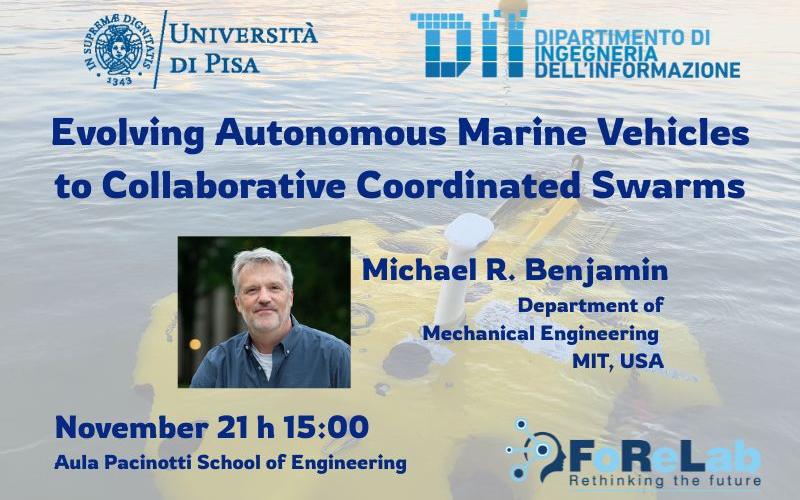Due giorni di missione del nostro team di robotica subacquea assieme a staff e volontari del WWF per cercare rifiuti di plastica nel Lago di Garda
Leggi tuttoEvolving Autonomous Marine Vehicles to Collaborative Coordinated Swarms

Aula Pacinotti,
Scuola di Ingegneria
Università di Pisa
Largo L.Lazzarino 1 Pisa
Abstract
The MIT Marine Autonomy Lab has been developing an open source marine autonomy code-base for the last 20+ years, initially publicly available in2006. This code has been used on dozens of marine robotic platforms around the world in academic projects, industry robots, defense prototypes, and more recently in defense program-of-record systems. In the past eight years, our lab's research focus has shifted to missions where multi-agent collaborative autonomy is a core requirement. This is partly due to the rapidly expanding commercial capacity for inexpensive (bordering on attritable) unmanned systems. While deployments purely in large numbers offers greater potential for distributed sensing capability, coordinated deployments offer even more potential. In the autonomous underwater vehicle (AUV) realm, this is becoming more feasible with lower cost communications hardware and through dynamic coordination with surface vehicles as communications and navigation aids. This trend has been ongoing for arguably ten years or more. In the autonomous surface vehicle (ASV) domain, there is a relative explosion of interest in coordinated swarms of small to medium size ASVs. This trend has evolved from near zero interest three years ago, to a desire to deploy hundreds of coordinated ASVs in the next two years. In this talk, an overview of the MIT autonomy system is provided, followed by a discussion of the augmentations to the core autonomy software to accommodate collaborative swarms.
BIO
Dr. Michael R. Benjamin is a Principal Research Scientist in MIT's Department of Mechanical Engineering and leads the MIT Marine Autonomy Lab. He specializes in algorithms and software for autonomous marine vehicles and is the founder and maintainer of MOOS-IvP (moos-ivp.org), the world's largest open-source project in marine autonomy, used on dozens of unmanned platforms. His pioneering work introduced a behavior-based architecture and multi-objective interval programming for robust decision-making, underpinning modern collision-avoidance and multi-vehicle coordination. At MIT he teaches 2.680 (Unmanned Marine Vehicle Autonomy,
Sensing, and Communication) and co-instructed 2.S01 (Introduction to AUVs). Before MIT, he was at the Naval Undersea Warfare Center, where he received the NAVSEA Scientist of the Year award.
Dr. Benjamin's achievements include patents in autonomous navigation and NATO's 2017 Science Award for networked ASW systems.



